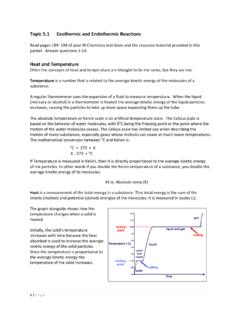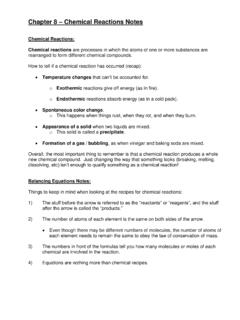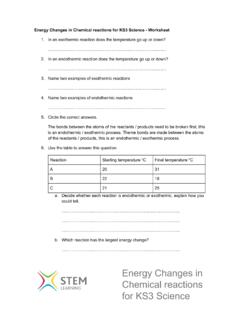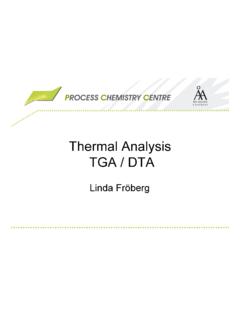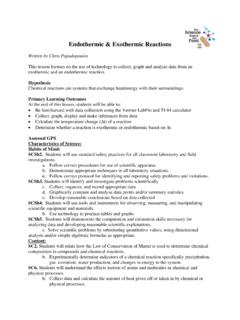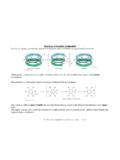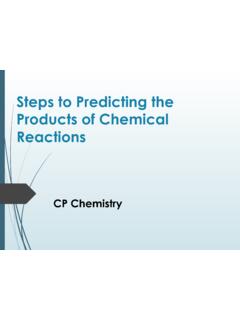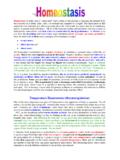Transcription of Chemical Reactions of Copper and Percent Yield
1 Chemical Reactions OF Copper AND Percent Yield KEY Objective To gain familiarity with basic laboratory procedures, some chemistry of a typical transition element, and the concept of Percent Yield . Apparatus and Chemicals g piece of no. 16 or no. 18 Copper wire evaporating dish 250 mL beaker (2) weighing paper concentrated HNO3 (4 6 mL) M H2SO4 (15 mL) graduated cylinder granular zinc M NaOH (30 mL) methanol carborundum boiling chips acetone stirring rod towel iron ring and ring stand balance wire gauze aluminum foil cut in 1-inch squares Bunsen burner concentrated HCl (drops) Discussion Most Chemical synthesis involves separation and purification of the desired product from unwanted side products. Some methods of separation, such as filtration, sedimentation, decantation, extraction, and sublimation were discussed earlier.
2 This experiment is designed as a quantitative evaluation of your individual laboratory skills in carrying out some of these operations. At the same time you will become more acquainted with two fundamental types of Chemical Reactions - redox Reactions and metathesis (double-displacement) Reactions . By means of these Reactions , you will finally recover the Copper sample with maximum efficiency. The Chemical Reactions involved are the following. Cu(s) + 4 HNO3(aq) Cu(NO3)2(aq) + 2 NO2(g) + 2 H2O(l) Redox [1] Cu(NO3)2(aq) + 2 NaOH(aq) Cu(OH)2(s) + 2 NaNO3(aq) Metathesis [2] Cu(OH)2(s) CuO(s) + H2O(g) Dehydration [3] CuO(s) + H2SO4(aq) CuSO4(aq) + H2O(l) Metathesis [4] CuSO4(aq) + Zn(s) ZnSO4(aq) + Cu(s) Redox [5] Each of these Reactions proceeds to completion.
3 Metathesis Reactions proceed to completion whenever one of the components is removed from the solution, such as in the formation of a gas or an insoluble precipitate (driving forces). This is the case for reaction [1], [2], and [3], where in Reactions [1] and [3] a gas and in reaction [2] an insoluble precipitate are formed. Reaction [5] proceeds to completion because zinc has a lower ionization energy or oxidation potential that Copper . CHEMISTRY - NCHS Lab: Reactions of Copper and Percent Yield Page 1 of 8 The objective in this experiment is to recover all of the Copper you begin with in analytically pure form. This is the test of your laboratory skills. The Percent Yield of the Copper can be expressed as the ratio of the recovered weight to initial weight, multiplied by 100: % Yield = x 100 Procedure Weight approximately g of no.
4 16 or no. 18 Copper wire (1) to the nearest g and place it in a 250 mL beaker. Add 4-5 mL of concentrated HNO3 to the beaker, IN THE HOOD. After the reaction is complete, add 100 mL distilled H2O. Describe the reaction (6) as to color change, evolution of gas, and change in temperature (exothermic or endothermic ) in the report sheet. Add 30 mL of M NaOH to the solution in your beaker and describe the reaction (7). Add two or three boiling chips and carefully heat the solution -- while stirring with a glass stirring rod -- just to the boiling point. Describe the reaction on your report sheet (8). Remove the boiling chips. Allow the black CuO to settle; then decant the supernantant liquid. Add about 200 mL of very hot distilled water and allow the CuO to settle.
5 Decant once more. What are you removing by washing and decanting (9)? Add 15 mL of M H2SO4. What Copper compound is present in the beaker now (10)? Your instructor will tell you whether you should use Zn or Al for the reduction of Cu (II) in the following step. A. Zinc In the hood, add g of 30-mesh zinc metal all at once and stir until the supernatant liquid is colorless. Describe the reaction on your report sheet (11). What is present in solution (12)? When gas evolution has become very slow, heat the solution gently (but do not boil) and allow it to cool. What gas is formed in this reaction (13)? How do you know (14)? B. Aluminum In the hood, add several 1-inch squares of aluminum foil and a few drops of concentrated HCl.
6 Continue to add pieces of aluminum until the supernatant liquid is colorless. Describe the reaction on your report sheet (11). What is present in solution (12)? What gas is formed in this reaction (13)? How do you know (14)? When gas evolution has ceased, decant the solution and transfer the precipitate to a preweighed porcelain evaporating dish (3). Wash the precipitated Copper with about 5 mL of distilled water, allow to settle, decant the solution, and repeat the process. What are you removing by washing (15)? Wash the precipitate with about 5 mL of methanol (KEEP THE METHANOL AWAY FROM FLAMES _ IT IS FLAMMABLE!) Allow the precipitate to settle, and decant the methanol. (METHANOL IS ALSO EXTREMELY TOXIC: AVOID BREATHING THE VAPORS AS MUCH AS POSSIBLE.)
7 Finally, wash the precipitate with about 5 mL of acetone (KEEP THE ACETONE AWAY FROM FLAMES - IT IS EXTREMELY FLAMMABLE!), allow the precipitate to settle, and decant the acetone from the precipitate. Prepare a steam bath as illustrated and dry the product on your steam bath for at least 5 minutes. Wipe the bottom of the evaporating dish with a towel, remove the boiling chips and weigh the evaporating dish plus Copper (2). Calculate the final a\weight of Copper (4). Compare the weight with your initial weight and calculate the Percent Yield (5). What color is your Copper sample (16)? Is it uniform in appearance (17)? Suggest possible sources of error in this experiment (18). CHEMISTRY - NCHS Lab: Reactions of Copper and Percent Yield Page 2 of 8 recovered weight of Cu initial weight of Cu CuCu Chemical Reactions of Copper and Percent Yield KEY Pre-lab (Review Questions) 1.
8 Give an example, other than the ones listed in this experiment, of redox and metathesis Reactions . Redox: Zn + MgCl2 ZnCl2 + Mg Zinc is oxidized: Zn0 Zn2+ + 2e- Magnesium is reduced: Mg2+ + 2e- Mg0 Metathesis: Pb(NO3)2 + H2S PbS + HNO3 (metathesis is also known as a double-replacement reaction) 2. When will Reactions proceed to completion? Driving forces for double replacement reaction is formation of water, gas or a solid. Single replacement Reactions we use an activity series to predict if they will occur. For a reaction to proceed to completion all of the reactants must mix: they may need to be stirred, or heated to assist in the process of them reacting. 3. Define Percent Yield in general terms.
9 Percent Yield is a measure of how well the reaction proceeded to completion. The formula for Percent Yield is the experimental Yield divided by the calculated (theoretical Yield ). 4. Name six methods of separating materials. a) filtration b) magnetism c) centrifugation d) decantation e) color f) distillation 5. Give criteria in terms of temperature changes for exothermic and endothermic Reactions . Exothermic Reactions - release heat and feel hot to the touch endothermic reaction - gain heat and feel cold to the touch 6. If g of Cu(NO3)2 are obtained from allowing g of Cu to react with excess HNO3, what is the Percent Yield of the reaction? g Cu + 2 HNO3 Cu(NO3)2 + H2 g excess x g x g Cu(NO3)2 = g Cu = g Cu(NO3)2 CHEMISTRY - NCHS Lab: Reactions of Copper and Percent Yield Page 3 of 8 g g 1 mol Cu(NO3)2 g Cu 1 mol Cu 1 mol Cu CuCu g Cu(NO3)2 1 mol Cu(NO3)2 % = % = 60% Yield Prelab Chemical Reactions of Copper and Percent Yield KEY 7.
10 What is the maximum Percent Yield in any reaction? 100%; any value higher would be impurities in product ( water, by-product) 8. What is meant by the terms decantation and filtration? Decantation - pour off solvent leaving behind precipitate Filtration - pass through filter that separates our components of a mixture by differences in particle size 9. When Cu(OH)2(s) is heated, Copper (II) oxide and water are formed. Write a balanced equation for the reaction. Cu(OH)2(s) CuO(s) + H2O(g) 10. When sulfuric acid and Copper (II) oxide are allowed to react, Copper (II) sulfate and water are formed. Write a balanced equation for this reaction. H2SO4(aq) + CuO(s) CuSO4(aq) + H2O(l) 11. When Copper (II) sulfate and aluminum are allowed to react, aluminum sulfate and Copper are formed.



